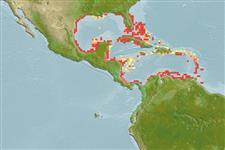Actinopterygii (Straalvinnigen) >
Perciformes (Perch-likes) >
Blenniidae (Combtooth blennies) > Salariinae
Etymology: Hypsoblennius: Greek, hypsi = high + Greek, blennios = mucus (Ref. 45335); invemar: Invemar (acronym) = in honor of the Instituto de Investigaciones Marinas de Punta Betin at Santa Marta, Colombia (Ref. 94455).
Omgeving / Klimaat / Range
Ecologie
; marien demersaal; diepteverspreiding 1 - 5 m. Tropical, preferred ?; 30°N - 9°N
Western Atlantic: Louisiana, USA and the Gulf of Mexico (Ref. 13628) to Rio de Janeiro, Brazil (Ref. 57756).
Size / Gewicht / Leeftijd
Maturity: Lm ? range ? - ? cm
Max length : 5.8 cm TL mannelijk/geslacht niet bekend; (Ref. 7251)
Dorsale stekels (totaal): 12; Dorsale zachte stralen (totaal): 12; Anale stekels 2; Anale zachte stralen: 14. Head and usually pectoral fin base have orange spots on dark background. Black spot on side of head behind eye (Ref. 26938). Gill opening extending ventrally to below level of ventralmost pectoral-fin ray; segmented dorsal-fin rays 11 or 12; segmented pelvic-fin rays 4; last dorsal-fin spine 3.7 to 7.5% SL (Ref. 10696).
Adults live in attached, empty barnacle shells in clear waters, usually on pilings, buoys and rock ledges at or near surface. Recorded from oil platforms. Oviparous. Eggs are demersal and adhesive (Ref. 205), and are attached to the substrate via a filamentous, adhesive pad or pedestal (Ref. 94114). Larvae are planktonic, often found in shallow, coastal waters (Ref. 94114).
Life cycle and mating behavior
Geslachtsrijpheid | Voortplanting | Kuitschieten | Eieren | Fecundity | Larven
Oviparous, distinct pairing (Ref. 205).
Robins, C.R. and G.C. Ray, 1986. A field guide to Atlantic coast fishes of North America. Houghton Mifflin Company, Boston, U.S.A. 354 p. (Ref. 7251)
Status op de Rode Lijst van het IUCN (Ref. 115185)
CITES (Ref. 94142)
Not Evaluated
Gevaarlijk voor mensen
Harmless
Gebruik door de mens
Meer informatie
ReferentiesAquacultuurAquacultuurprofielKweeklijnenGeneticaAlleelfrequentiesErfelijkheidZiektenVerwerkingMass conversion
Tools
Speciale rapporten
Download XML
Internet-bronnen
